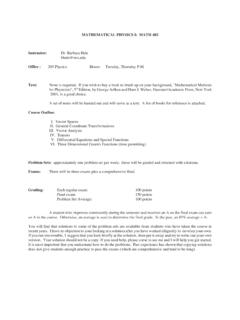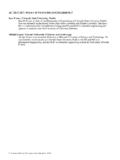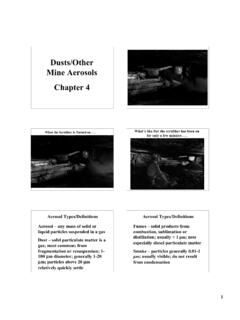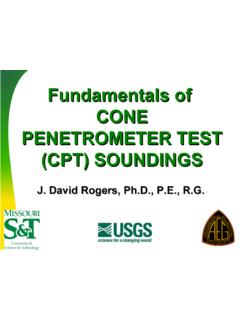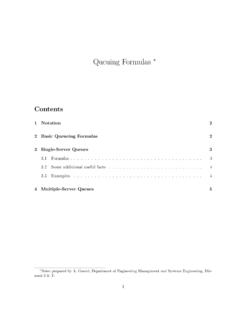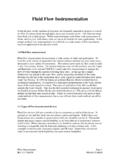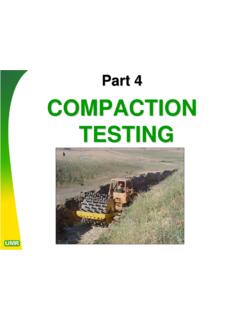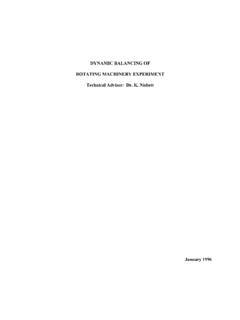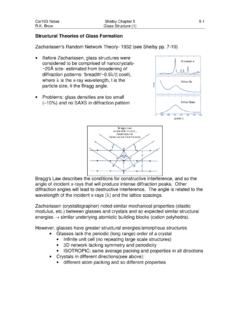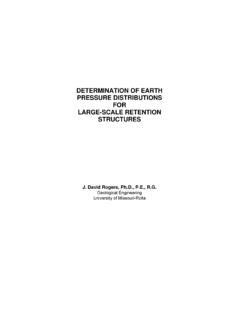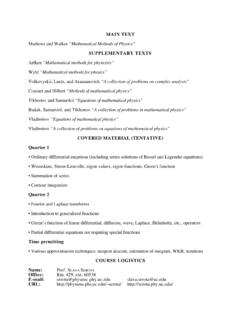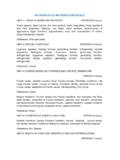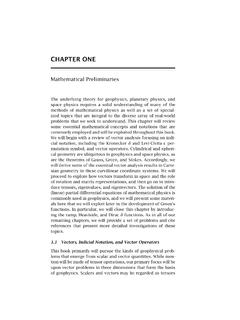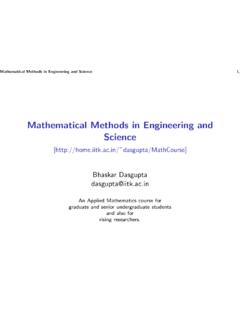Transcription of Syllabus of Mathematical Physics I (Math 402) - …
1 Syllabus of Mathematical Physics I (Math 402)(University of Missouri-Rolla)(This course is based on a set of notes developed to give the students Mathematical "tools" for problem solving. Severalreferences are suggested, but no text is required. All students receive copies of the notes and (after grading) solutionsto problems and exams.)I. Vector SpacesDefinitions of field, vector space, inner product, norm, metric; unitary vector space, normed vector space,orthogonality, Schmidt orthogonalization procedure, linear independence, completeness; basis vectors, dimension; lineartransformations, powers of operators; Hermitian conjugate, Hermitian orthogonal and unitary operators; threedimensional Euclidian space.
2 Transformations between Cartesian coordinate systems: Euler angle Generalized Linear Coordinate TransformationsContravariant and covariant vectors and the transformation matrices, Aij; Kronecker delta, ij, Levi-Civita symbol, ijk, ijk; metric tensor, ds2=gijdqidqj; g = ATA, spherical coordinate system, use of gij to relate covariant and contravariantcomponents, u-1 basis vectors in the general qi coordinates system; obtaining contravariant (covariant) components ofF; FiFi invariance; determinant in summation notation; covariant forms for gradient, Laplacian, curl and divergence; useof covariance in working Tensors Under Generalized Coordinate TransformationsDefinition of tensor; rank, symmetric tensors, contraction, quotient rule; tensors with zero components, tensorequations, metric tensors and their determinants; pseudo tensors; transformation of ijk/ Vector AnalysisDifferential, dF = [dr ] F(r); directional derivative, dnF/dsn = [s^ ]n F(r) ; Taylor series expansion, F(r+ r)= exp[ r ]F(r); physical interpretation of divergence and curl.
3 Manipulation of r, dr, in vector equations; vectoridentities and summation notation; angular momentum operator, L; L x L = i L; line integrals; surface integrals; dA= dxidxj /[|nij f|/| f|] ; three dimensional integrals; divergence theorem; Stokes theorem; xF= 0 F = - ;Helmholtz theorem (F(r) from curl and divergence of F), Maxwell's equations, Dirac delta function, charge densitiesfor simple geometries; step function and its Differential Equations and Special FunctionsDifferential operators, common partial differential equations of Physics ; techniques for solving partial differentialequations; general solution; homogeneous and non-homogeneous equations; Poisson's eq.
4 ; solutions to = 0 inCartesian, spherical and cylindrical coordinates; plane and spherical waves; Laplacian in terms of angular momentumoperator; second order linear ordinary differential equations; Greens' functions in one dimension; boundary conditions;self adjoint operators; hermitian operators; series solution method; Fuch's theorem, general solutions to:hypergeometric, confluent hypergeometric, associated Legendre, Legendre, associated Laguere, Hermite, Bessel, andspherical Bessel equations; Hankel functions, gamma function; spherical harmonics; expansions of 1/|r-r'| ;Schrodinger equation for H atom.
5 REFERENCES TEXTS FOR MATH 402 , George " Mathematical methods for Physicists" Second Edition, Academic Press, New York, is a good book for review and reference. Vector analysis, coordinate systems, tensor analysis,determinants, matrices, infinite series, Green's , R. and Hilbert, D. " methods of Mathematical Physics ", Vol. I. Interscience Publishers, Inc. ,1937. Has good treatment of n-dimensional vectors, orthogonal systems, norms, unitary transformations andeigenvalue , R. "Lectures in Mathematical Physics ", Vol.
6 I. Benjamin, Inc., , 1970 Vector spaces,linear transformations, tensors, matrices, linear ordinary differential equations,eigenvectors, Green's functions; Hilbert , Mary L. " Mathematical methods in the Physical Sciences" John Wiley and Sons, Inc., , 1966 Elementary book - good for , John and Mason, Robert "Applied Matrix and Tensor Analysis" Wiley - Interscience, , 1970 Good book for study of , Guido " Mathematical methods of Quantum Mechanics" Mc-Graw Hill, , 1971 Finite dimensional linear space and matrices measure theory, Hilbert Space, brief survey of , Jon and Walker, " Mathematical methods of Physics " Benjamin, Inc.
7 , , 1970 Thisbook treats a broad range of advanced topics: ordinary differential equations; infinite series, evaluation ofintegrals, integral transforms; complex variables, vectors and matrices, special functions; partial differentialequations; eigenfunctions, eigenvalues, Green's function perturbation theory, integral equations; calculus ofvariations probability and statistics, tensor analysis; group book covers these subjects with very few details. It was meant as an outline for students to follow inpursuing these topics on their , Philip M.
8 And Feshbach, Herman " methods of Theoretical Physics " Mc-Graw Hill, , 1953,Volumes I and II Good reference book; some material for course will be taken from these books - but notenough to warrant buying either , Granino A. and Korn, Theresa M. " Mathematical Handbook for Scientists and Engineers" Containsan excellent, concise, and detailed summary of just about any Mathematical topic you are likely to encounterin classwork or research. This is a very good reference book! Consider buying this book for your library(not required or advised for this course specifically).
9 , Milton and Stegun, Irene A. "Handbook of Mathematical Functions" National Bureau ofStandards Applied Mathematics Series 55, Washington, , 1964 Gamma functions, error functions,Fresnel integrals, Bessel functions, confluent hypergeometric functions, elliptic integrals, Coulomb book has formulas, graphs and tables. A very good and inexpensive reference book! , "A Treatise on the Theory of Bessel Functions" University Press, Cambridge, 1958 All about Bessel Functions - good , Peter Gabriel "Introduction to the Theory of Relativity" Dover, New York 1976.
10 Chapter V hasa very good (and complete) discussion of Vector and Tensor should find this , "Introduction to Vector and Tensor Analysis" Dover Publications, New York, , David and Rund, Hanno "Tensors, Differential Forms and Variational Principles". , "Applied Analytical Mathematics for Physical Scientists" John Wiley and Sons, Inc., NewYork, 1975. This book is more theoretically than practically oriented -- but it should provide background forthe class notes and some extra explanations. , B. and Smith, "Functions of Mathematical Physics " Van Nostrand Reinhold Company, NewYork, 1970.
